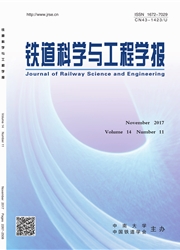

 中文摘要:
中文摘要:
以某(88+152+88)m连续梁桥为工程背景,建立了采用液体黏滞阻尼器(FVD)的减震模型,采用非线性动力时程分析方法研究粘滞阻尼器对该桥抗震性能的影响。通过粘滞阻尼器在不同位置的布设,得出了最优的布置方案;通过基于阻尼力的参数分析,得出了最优的阻尼器型号。研究结果表明:"-3地震力较大时,单独采用阻尼器并不能完全达到理想的效果,此时,设置减震专用支座(SSAB)与阻尼器配合使用可进一步改善桥墩受力;减震专用支座可按滞后系统进行模拟,分析时可基于2种极端状况来模拟其恢复力模型,取屈服强度为设定的减震专用支座水平力限值时计算结果可控制设计。
 英文摘要:
英文摘要:
On the background of a (88 plus 152 plus 88)m long- span continuous beam bridge, the damping model with fluid viseons dampers (FVDS) employed was established by introducing nononlinear alynamic time course analysis approach to estimate the influence of FVDS on the seismic isolation effect of the bridge. The rea- sonable and feasible FVD positions and types were subsequently derived through the layout of FVDS at different sites and the parametric analysis of resistant forces. The results show that, when the horizontal earthquake force is greater than horizontal force limitation of the settled bearing, the mixture application of special seismic absorp- tion bearing(SSAB) and fluid viscous damper(FVD) should be adopted to render the force state of piers more applicable than that of the case with FVDs alone. The mechanic of SSAB was simulated by the mechanical model for time -delay system and analyzed by the restoration model under two extreme conditions, whose design force can be limited by the settled horizontal maximum force equivalent to the yield strength.
 同期刊论文项目
同期刊论文项目
 同项目期刊论文
同项目期刊论文
 A new two-node catenary cable element for the geometrically non-linear analysis of cable-supported s
A new two-node catenary cable element for the geometrically non-linear analysis of cable-supported s An experimental study on using MR damper to mitigate longitudinal seismic response of a suspension b
An experimental study on using MR damper to mitigate longitudinal seismic response of a suspension b 期刊信息
期刊信息
